How to Troubleshoot Common Electrical Problems in Your Home

It can be frustrating to encounter an electrical problem when you really don’t know what to do. Electrical failures can result from something as complex as an outdated and faulty wiring system or as simple as circuit breakers tripping. With electrical troubleshooting, you can identify the root of the problem and do the necessary electrical repairs to fix it. This article gives tips to help you troubleshoot common electrical problems in your home
5 Most Common Electrical Problems at Home: Prevention and Repair Tips
1. Light Switch Not Working
An unreliable light switch that fails to turn on lights can be a nuisance. This electrical issue can be caused by the age of the switch, defective parts, or a mistake in installation. Start by checking the light bulb to ensure it works. You can test it in a different light fixture.
Check the circuit breaker to ensure it is on and test the outlet close to the light switch to confirm if power is moving to the circuit. While the danger level for this electrical issue might be low, you need a professional electrician to help you fix the problem.
2. Tripped Circuit Breaker

A circuit breaker can trip due to high power consumption from a single outlet. The danger level is often high because you are overloading a circuit. Keep an eye on your circuit breaker to determine when it trips. Perhaps it could be after turning on your HVAC system or immediately after you start a device. Your circuit breaker can also trip due to a short circuit.
Try to unplug some high-power devices and flip the switch of your circuit breaker. Keep in mind that circuit breakers help enhance your safety by preventing electrical fires and other disasters when you exceed the voltage your breaker is designed to handle.
3. Lots of Electrical Surges
Frequent electrical surges can damage your electronic devices connected to the grid. They mostly happen when the power fades for a moment or turns off and then suddenly increases voltage in an electrical circuit. Most surges happen across the entire grid, mostly during lightning storms. The best way to go about this is to call Sherwin Electrical experts for a thorough inspection. The professional can assess your entire wiring system and grid to identify the culprit.
4. Electrical Shocks

If you are feeling a mild shock as soon as you turn on a device or plug in an appliance, you could have faulty wiring or a faulty appliance. Considering it could result from faulty wiring, the safest way to troubleshoot this electrical issue is to engage the services of an experienced electrical expert.
5. High Electric Bill
A higher-than-normal electric bill could be due to high power consumption by some appliances. Alternatively, it can result from wiring issues or damaged circuits that can lead to sparks and even fire.
If your power bill shoots high for the first time, try to track your energy use and what you might have done differently that month. For instance, the first hot month of the year can cause your bill to go up due to an increased use of air conditioning.
Read More: Home Safety Checklist: Top Tips To Protect Your Loved Ones And Property
Conclusion
An unexpected or random spike can indicate a problem; either you have a serious electrical problem in the house, or your electrical provider overcharges you. A few solutions for random spikes include unplugging appliances, chargers, and electronic devices when not in use. Also, determine the appliances that increase your power bill, fix leaks in your hot water system, and let your electrical contractor repair your wiring and outlets.
By knowing how to troubleshoot home electrical issues, you will know what problems you can solve on your own and when to engage a professional electrician. Always inspect your electrical system to ensure it is in good shape and avoid costly damages.

news via inbox
Sign up and never miss out on the latest news and updates at HighStuff



